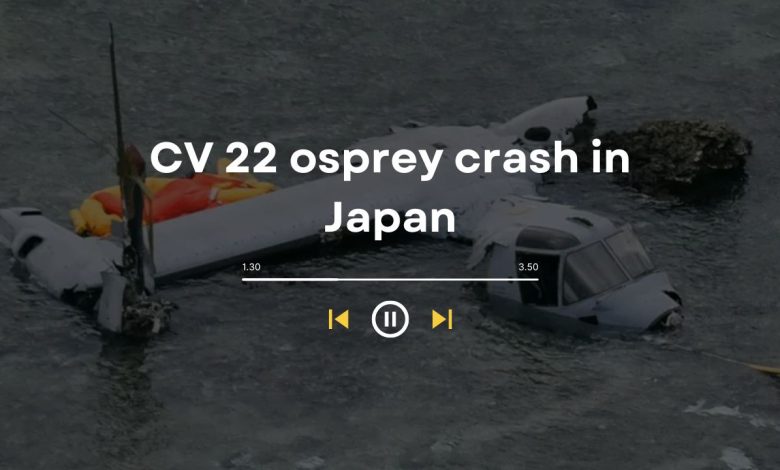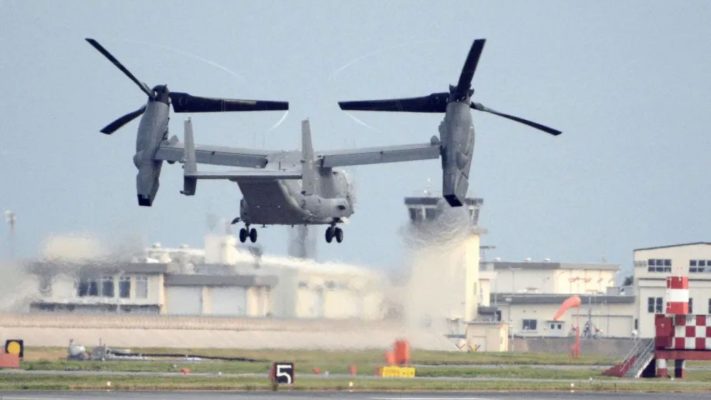
On November 29, a tragic incident unfolded along the southern coast of Japan as the CV-22 Osprey crashed, resulting in the loss of seven courageous airmen. The U.S. Air Force, tasked with the solemn duty of revealing the identities of the fallen heroes, has highlighted the profound impact of this aviation catastrophe. As we delve into the details of this unfortunate event, our primary focus remains on honoring the bravery and selflessness exhibited by these airmen. This comprehensive report, presented by Nowviralvideo.com, your go-to source for insightful coverage, explores the complexities surrounding the CV 22 osprey crash Japan and its wide-ranging consequences.
Contents
- I. Incident Details: CV-22 Osprey Crash in Japan
- II. Responding to the CV-22 Osprey Crash in Japan: Search and Recovery Efforts
- III. Air Force Statements and Reactions: Reflections on theCV 22 osprey crash Japan
- IV. Osprey Crash 2023: Historical Context, Significance, and Fallen Personnel
- V. Navigating Challenges Post Osprey Crash 2023: Osprey Fleet Issues and Investigation
- VI. Osprey Crash 2023: Eyewitness Account, International Response, and Tribute to the Fallen
- VII. Frequently Asked Questions (FAQs)
I. Incident Details: CV-22 Osprey Crash in Japan
During a routine training mission, tragedy struck when the CV-22 Osprey, known as “GUNDAM 22,” crashed near Yakushima Island off the southern coast of Japan on November 29. The CV 22 osprey crash Japan incident resulted in the unfortunate loss of all eight crew members on board.
The victims included skilled individuals such as a CV-22 instructor pilot, a flight surgeon, and other dedicated personnel. The impact of this tragic event resonates deeply within the closely-knit community of military professionals.
As recovery efforts unfolded, the body of Staff Sgt. Jake M. Galliher was successfully retrieved on December 1, representing an initial step in the process. Ongoing efforts are being made to recover the remaining three personnel, whose identities have not been disclosed by the U.S. Air Force. The collaborative endeavors of U.S. and Japanese military and civilian search units, supported by local fishermen, underscore the commitment to bringing closure to this sorrowful chapter.
II. Responding to the CV-22 Osprey Crash in Japan: Search and Recovery Efforts
In the aftermath of the CV 22 osprey crash Japan the southern coast of Japan, a collaborative effort involving U.S. and Japanese military, along with civilian search units, has been in progress. The primary focus has transitioned from the initial urgency of locating survivors to the crucial task of recovering the remains of the remaining crew members.
This joint initiative, characterized by the combined contributions of military professionals and civilians from both nations, is further supported by the steadfast assistance of local fishermen. Together, they have been working tirelessly under challenging conditions to locate and retrieve the victims, demonstrating a shared commitment to providing closure to the families affected by this tragedy.
Within the context of the search and recovery mission, special emphasis is placed on retrieving scattered aircraft debris across the crash site. Notably, efforts are also directed towards recovering the CV-22 Osprey’s fuselage, which is submerged in the sea at a depth of approximately 30 meters (100 feet), as reported by the Japanese coast guard.
III. Air Force Statements and Reactions: Reflections on theCV 22 osprey crash Japan
Following the CV 22 osprey crash Japan, notable statements have been issued by key figures in the U.S. Air Force, shedding light on the severity of the incident.
Lt. Gen. Tony Bauernfeind, the commanding officer of Air Force Special Operations Command, has conveyed poignant sentiments, underscoring the importance of the fallen airmen. His remarks depict them as “among the giants who shape our history,” emphasizing the profound influence of their service on the nation’s legacy.
Moreover, there exists a collective acknowledgment within the Air Force regarding the persistent sorrow surrounding this tragic event. The commitment to preserving the airmen’s dedicated service is emphasized, recognizing the profound impact on both the military community and the affected families.
IV. Osprey Crash 2023: Historical Context, Significance, and Fallen Personnel
Within the realm of military aviation mishaps, the CV 22 osprey crash Japan the southern coast of Japan in 2023 stands out as a poignant event. In the wake of a series of Osprey crashes claiming the lives of 20 American troops over the past two years, this incident adds a sorrowful chapter to the ongoing narrative of contemporary military history.
Significantly, this marks the first fatal incident involving an Air Force-operated CV-22 since 2010, amplifying the gravity of the situation. Notably, the Osprey crash becomes the second lethal U.S. special operations mission in November, following a separate unfortunate occurrence involving a MH-60 Black Hawk helicopter earlier in the month.
In delving into the historical markers surrounding these events, it becomes imperative to acknowledge and honor the individuals who made the ultimate sacrifice. The fallen airmen, casualties of the CV 22 osprey crash Japan in 2023, have become indelible names within this somber narrative, their memory woven into the broader historical fabric.
As we investigate the status of the U.S. Osprey fleet, recent issues have surfaced, demanding thorough examination. A significant focal point is the occurrence of “hard clutch engagements,” instances where the Osprey’s clutch experiences temporary slips and re-engagements, resulting in an uneven distribution of power to its rotors. These slips present potential hazards, causing the aircraft to lurch dangerously and adding complexity to the operational integrity of the fleet.
The heightened concerns are further accentuated by the recent Osprey crash off the southern coast of Japan in 2023, following the CV 22 osprey crash Japan incident. An air of uncertainty surrounds the investigation, raising questions about the potential involvement of a faulty clutch in the mishap. As the U.S. Air Force takes the lead in unraveling the circumstances leading to the crash, a comprehensive examination is underway to identify the root cause and address future risks.
In response to these challenges, Osprey operations in Japan have been temporarily suspended, underscoring a commitment to prioritizing safety. Additionally, routine Osprey flights by the U.S. Air Force have been halted temporarily, with a redirection of focus towards an in-depth investigation into the Osprey crash of 2023.

VI. Osprey Crash 2023: Eyewitness Account, International Response, and Tribute to the Fallen
An eyewitness account from Yakushima Island provides a firsthand perspective on the tragic CV 22 osprey crash Japan in 2023. The resident describes the Osprey’s inverted position, the alarming sight of an engine on fire, and a subsequent explosion, culminating in the aircraft’s descent into the sea. This detailed narrative highlights the gravity of the incident, offering crucial insights for the ongoing investigation into the CV-22 Osprey crash in Japan.
Japan has responded decisively to this catastrophic event by suspending Osprey operations within its borders, demonstrating a commitment to reevaluating safety protocols for these aircraft. Simultaneously, there are calls for the U.S. to adopt a comparable stance, emphasizing the necessity of a comprehensive assessment of Osprey operations worldwide following the CV-22 Osprey crash in Japan.
On the global stage, Defense Secretary Lloyd Austin has taken a proactive role, expressing unwavering dedication to a thorough investigation. His recognition of collaborative efforts with Japan is coupled with genuine appreciation for the assistance provided in the aftermath of the Osprey crash. This international response underscores the significance of unity and transparency in addressing such tragic incidents related to the CV-22 Osprey crash in Japan.
VII. Frequently Asked Questions (FAQs)
1. How did the Osprey crash in Japan?
The recent CV-22 Osprey crash in Japan has left uncertainties regarding the cause of the incident, including the possibility of a faulty clutch being a contributing factor. An eyewitness from Yakushima reported to NHK, a Japanese news outlet, that the CV-22 Osprey flipped upside down, exhibited signs of engine fire, and eventually exploded before plunging into the sea, as documented by the Associated Press.
2. Why did Japan Airline 123 crash?
On August 12, 1985, the CV-22 Osprey crashed in Japan, experiencing a catastrophic structural failure and decompression merely 12 minutes into the flight. With limited control, the aircraft continued flying for an additional 32 minutes before ultimately crashing near Mount Takamagahara, approximately 100 kilometers (62 miles; 54 nautical miles) from Tokyo.
3. What was the worst plane crash in Japan’s history?
On August 12, 1985, the crash of Japan Airlines flight 123 in southern Gumma prefecture, Japan, northwest of Tokyo, resulted in the tragic loss of 520 lives. This aviation disaster, occurring near the city of Ueno, stands as one of the deadliest single-plane crashes in history. The incident has left a lasting impact on the aviation community, akin to the gravity associated with other catastrophic events such as the CV-22 Osprey crash in Japan.
4. How many V-22 Ospreys are there?
The CV-22 Osprey crash in Japan was a significant incident involving one of the primary users, the United States Air Force. This tiltrotor aircraft, developed from the Bell XV-15, has been in production since 1988 and has seen a total of 400 units built as of 2020. The United States Marine Corps, United States Navy, and Japan Ground Self-Defense Force are also among the primary users of the V-22 Osprey. The crash raised concerns about the safety and reliability of this aircraft, prompting a closer examination of its operational aspects and potential impact on future deployments.
>>> See more: Jamaican Rapper Born 1973: Musical Style


![[FULL] Watch Trisha Kar Madhu Viral Video On Internet 5 Watch Trisha Kar Madhu Viral Video On Internet](https://nowviralvideo.com/wp-content/uploads/2023/08/trisha-kar-madhu-viral-video-390x220.jpg)
![[FULL] Watch Viral Video Woman On Plane Not Real 6 Watch Viral Video Woman On Plane Not Real](https://nowviralvideo.com/wp-content/uploads/2023/08/viral-video-woman-on-plane-not-real-390x220.jpg)